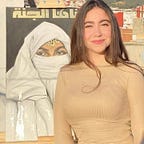An art style I’m currently obsessed with: Rococo Art Style
If you are a sucker for Cinderella-like clothing, overly feminine, and fluffy luxurious stuff, the Rococo art style is your aesthetic.
A couple of days ago, I came across a designer who creates corsets out of French Rococo tapestries, and I started reading more about it until I grew overly obsessed with the Rococo Art Style. That led me to share a quick, informative article in hopes it would inspire you or give you an idea about it.
1- History of the Rococo Art Style
The Rococo movement began in France, and it was a response to the more toned-down style that was popularized by French King Louis XIV.
As an art style, Rococo was immersed in the mid-1700s and was known for joyful themes of love, wealth, and nature. Rococo followed the Baroque era after about 100 years, yet some people still get them mixed up.
The difference is pretty easy to spot, in my opinion. Baroque art pieces are serious and realistic with more of a dramatic feel to them, while Rococo is more fun, naughty, and libertine.
If you’re not familiar with the style, one of the most famous Rococo Art Style paintings is “The Swing” by Jean-Honoré Fragonard. A poet’s account has it that the history painter Doyen was approached by an “unnamed person” or gentleman of the court who wanted to commission him to paint a picture of his mistress on a swing, with him in the bushes hiding, and being pushed by a bishop. He specifically said the lady on the swing should be showing her ankles and more if you want to enliven the picture further. Doyen was a little bit scandalized by this, and he suggested that, instead, Fragonard take over the commission. And so this painting was made in 1767.
A closer look at the composition
If we take a close look at the triangular composition of the painting, we can see that it’s a love triangle. The lady is sitting on the swing, precariously balanced between two people: her husband on the back pulling the swing and her fancy man at the front looking up her skirt. The woman is represented in the center with softer colors, showing that she holds power and beauty at the moment, but the precarious swing position shows us that it might not last. (Source)
This is another well-known painting of the french Rococo era, Boucher was very famous, and produced many idyllic and voluptuous paintings on classical and romantic themes. The painting shows a lady being herself completely (barefoot, not caring much about her clothes or hat), and comfortably reading the secret letter that was sent to her by a pigeon. The only witnesses to the lady reading the letter are the three angels and the pigeon.
Image via Wikimedia Commons.
Were these paintings made to undercut French eighteenth-century society?
Not at all! French eighteenth-century society, at this time, was quite libertine. But they still had quite strict rules and regulations and one of those was that men were allowed, mistresses. Women possibly could have a fancy man if they wanted, however, they first had to provide a male heir to their husband and be very discreet about it. So the rococo artists were not undercutting society but just putting overtly out there what everyone knew to be happening at the time.
Popular artists of the Rococo Art Style
Jean Antoine Watteau also known as the father of Rococo and is popular for his Fete Galante Genre works.
Jean Francois de Troy, inventor of Les tableaux de modes (‘paintings of fashions’).
Jean-Honoré Fragonard, a very known artist of the Rococo era, Among his most popular works, are genre paintings conveying an atmosphere of intimacy and veiled eroticism.
François Boucher, one of the most celebrated painters and decorative artists of the 18th century.
Rococo in Fashion
Rococo’s fashion is just how I’d rather be dressing right now. It was based on extravagance, elegance, refinement, and decoration. Women’s fashion of the seventeenth century was contrasted by the fashion of the eighteenth century, which was ornate and sophisticated, the true style of Rococo.
Rococo in Architecture and interior design
The Rococo houses were made smaller in size to give a cozier feeling and vibe. The colors used in the architecture were mostly pastel tones with touches of gold and excessive amounts of detail.
The Rocaille and cartouches with asymmetrical and detailed curves were other features of Rococo decorations. They are pretty noticeable in the Helbling House in Innsbruck, Austria. And in Hôtel de Soubise, Paris, France. Although Hotel de Soubise was built in the Baroque era, the interior was redone in the Rococo period.
The Rococo Art Style was made to value a lavish lifestyle, so the furniture had to be super comfortable, visually pleasing, and elegant. Porcelain tableware, candelabras, and gold clocks were popular in the era. Take a look at the Würzburg Residenz, located in Würzburg, Bavaria, Germany. The excessive gold, sculptures, and porcelain details are surely the most iconic elements of Rococo’s architecture and interior design.
Conclusion
Rococo is one of the major movements in artistic and architectural history. Although it was a relatively short-lived style, lasting less than 100 years. Rococo took many of the aspects of Baroque and greatly enhanced them to bring elements of fun and joy to life.
